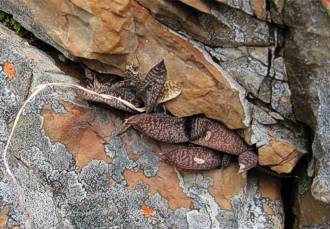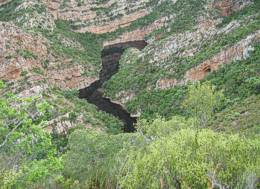Gasteria ellaphieae
Gasteria ellaphieae Van Jaarsv.
Family: Asphodelaceae
Common names: Ellaphie's gasteria
Introduction
Gasteria ellaphieae is a dwarf aloe-like, succulent-leaved plant (rock crevice plant) endemic to the Kouga Dam region of the Eastern Cape Province. It thrives in cultivation.

Description
Description
Plants without a stem (acaulescent), ascending (growing erect after an oblique or ± horizontal beginning), 15-40 mm tall (without flowers), 50-140 mm in diameter, solitary or proliferating from the base to form small clusters. Roots succulent, gradually dilating towards the middle (fusiform) and up to 5 mm in diameter.
Leaves at first opposite (distichous), becoming a rosette (rosulate), 20-50 mm long, 10-20 mm broad at the base, firm, triangular to triangular-lance-shaped to sickle-shaped (falcate), the inner ascending the outer recurved; the upper surface channelled; lower surface somewhat convex with an off-centre keel; both surfaces dark green, with dense white tubercles arranged in irregular transverse bands; the leaf tip is acute, bearing a short sharp point (mucro)
Inflorescence an ascending raceme, 250-450 mm long, solitary or branched in upper third. Pedicel 6 mm long. Perianth 25-27 mm long, reddish-pink, the base swollen for more than half its length. Stamens 20-25 mm long, anthers 2 mm long, oblong, included or protruding up to 2 mm. Style 16 mm long, exceeding the anthers at the end of the flowering period. Fruiting capsule 12-15 mm long, 5-6 mm in diameter. Seeds about 3 mm long, black, flattish.
Flowering period: January-February.

Gasteria ellaphieae is related to G. nitida which is a much larger grassland plant with a smooth leaf surface. The former is immediately recognized by its densely tuberculate, triangular, ascending to recurved leaves and ascending spreading reddish-pink racemes often branched in the upper half. It is an attractive dwarf species, and with its short triangular, recurved leaves it sometimes superficially resembles a Haworthia.
Conservation Status
Status
Although only known from the Kouga Dam region in the Eastern Cape, it is well protected by its inaccessible habitat. Plants grow on rugged terrain and cliffs within a protected nature reserve. The plant has been well established in cultivation (ex situ preservation) and is grown by succulent plant enthusiasts all over the world.
Distribution and habitat
Distribution description
Gasteria ellaphieae grows in a succulent-rich community often among thorny shrubs, small trees and herbs. Its habitat is a transition between Fynbos and Thicket. Typical small trees and shrubs in the habitat include Portulacaria afra, Boscia oleoides, Smelophyllum capense, Sterculia alexandri, Acokanthera oppositifolia, Thamnochortus fruticosus, Diospyros sp. and Cussonia gamtoosensis. Smaller associated succulents in the habitat include Crassula rupestris, C. pellucida subsp. marginalis, C. perforata, C. montana subsp. quadrangularis and a species of Anacampseros.
The climate is hot in summer and mild in winter. Annual rainfall is 300-400 mm, in summer and winter, but there is a tendency to summer dryness. The mountains surrounding the Kouga Dam consist of quartzitic sandstone (Peninsula Formation, Cape Supergroup). They range from about 600-800 m in altitude, with Gamtoos Thicket vegetation of the Albany Thicket Biome (Mucina & Rutherford 2006) on the lower slopes and Fynbos (Kouga Grassy sandstone Fynbos) on the upper slopes. The average annual daily maximum temperature is about 23°C and the average daily minimum about 10°C. Gasteria ellaphieae grows at an altitude of about 450-700 m.

Derivation of name and historical aspects
History
G. ellaphieae was named by the author in 1991 in the American Cactus and Succulent Journal. The specific epithet honours Ellaphie Ward-Hilhorst (1920-1994), well known South African botanical artist (Van Jaarsveld 1995a, 1995b). Ellaphie has illustrated Gasterias of southern Africa (1994) and is also well known for her work in the 3 volumes of Pelargoniums of South Africa (Van der Walt 1977, Van der Walt & Vorster 1981 and Van der Walt & Vorster 1988 ). Gasteria ellaphieae was discovered unexpectedly by the author in 1989 whilst searching for Aloe pictifolia plants, which are also endemic to the area.
Ecology
Ecology
Gasteria ellaphieae grows in larger to smaller lichen-rich crevices in the Kouga Dam area. It grows in dense thickets and fynbos but also on exposed cliffs. It flowers mainly during December and January (midsummer) but sporadically also at other times. The seeds are wind-dispersed. Seeds ripen during summer, coinciding with the rainy season. Like many other Gasteria species its leaves are brittle and will proliferate when fallen into a crevice. Gasteria ellaphieae is pollinated by sunbirds. The succulent leaves and roots enable the plant to cope with dry conditions. The mottled leaves blend in with the natural surroundings, and plants are thus well camouflaged from herbivores.
Uses
Use
Apart from its horticultural use, the plants are not used medicinally or otherwise.
Growing Gasteria ellaphieae
Grow

Gasteria ellaphieae thrives in cultivation and does best as a pot plant or grown in miniature rock gardens. G. ellaphieae is a slow grower. It can be grown out-of-doors, but is best cultivated in dry Mediterranean-type gardens where frost is not too severe. Plants prefer partial shade, and in hot climates should therefore be protected from full sun. Plants should reach flowering size in about 3 years.
Propagation
Easily propagated from seed, leaf cuttings or by division. It is best to apply a fungicide when growing from seed. Sow seed during spring or summer in a warm, shady position in a sandy slightly acidic soil. Cover with a thin layer of sand and keep moist. Germination is usually within 3 weeks. Seedlings grow slowly and are best planted out about a year after sowing. Propagation from leaf cuttings is best undertaken in spring. Allow the leaf cutting to form a heel by placing it on a dry window sill for a week or three. Cuttings are best rooted in clean sand. Once rooted, plants can be planted into individual containers. Plants react well to organic feeding (compost or any other liquid fertilizer). Gasteria ellaphieae is best watered throughout the year, but sparingly in winter.
References
- Mucina, L. & Rutherford, M.C. (eds) 2006. The vegetation of South Africa, Lesotho and Swaziland. Strelitzia 19. South African National Biodiversity Institute, Pretoria.
- Van der Walt, J.J.A. 1977. Pelargoniums of Southern Africa. Purnell. Capet Town, Johannesburg, London.
- Van der Walt, J.J.A. & Vorster, P.J. 1981. Pelargoniums of Southern Africa. Juta, Cape Town, Johannesburg.
- Van der Walt, J.J.A. & Vorster, P.J. 1988. Pelargoniums of Southern Africa. National Botanical Gardens, Cape Town.
- Van Jaarsveld, E.J. 1991. Gasteria ellaphieae Van Jaarsv., a new species from the south-east Cape. Cactus & Succulent Journal (US) 63, 1: 3-7.
- Van Jaarsveld, E.J. 1994. Gasterias of South Africa. Fernwood Press.
- Van Jaarsveld E. J. 1995a. Johanna Ellaphie Ward-Hilhorst (1920-1994) with specific reference to her work on succulent plants. Bradleya 13: 18-24.
- Van Jaarsveld, E. J. 1995b. Johanna Ellaphie Ward-Hilhorst (1920-1994), each tree is known by its own fruits. Lantern 33: 32-35.
- Van Jaarsveld, E.J. 2007. The genus Gasteria, a synoptic review. Aloe 44: 4: 84-103.
Credits
Ernst van Jaarsveld
Kirstenbosch National Botanical Garden
April 2011
Plant Attributes:
Plant Type: Succulent
SA Distribution: Eastern Cape
Soil type: Sandy
Flowering season: Early Summer
PH: Acid
Flower colour: Pink
Aspect: Shade
Gardening skill: Average
Special Features:
Horticultural zones








Rate this article
Article well written and informative
Rate this plant
Is this an interesting plant?
Login to add your Comment
Back to topNot registered yet? Click here to register.